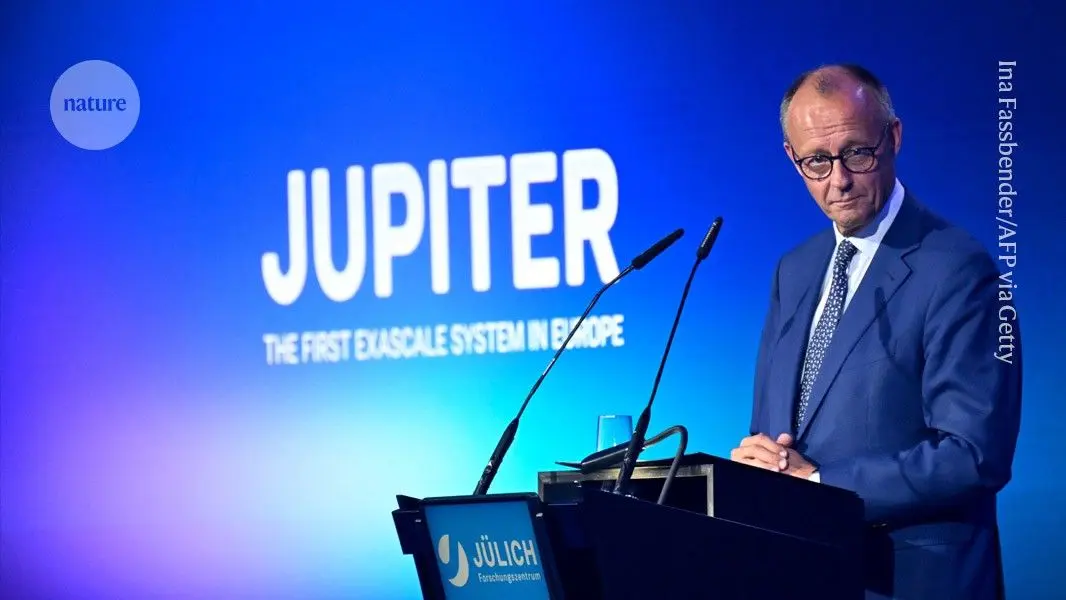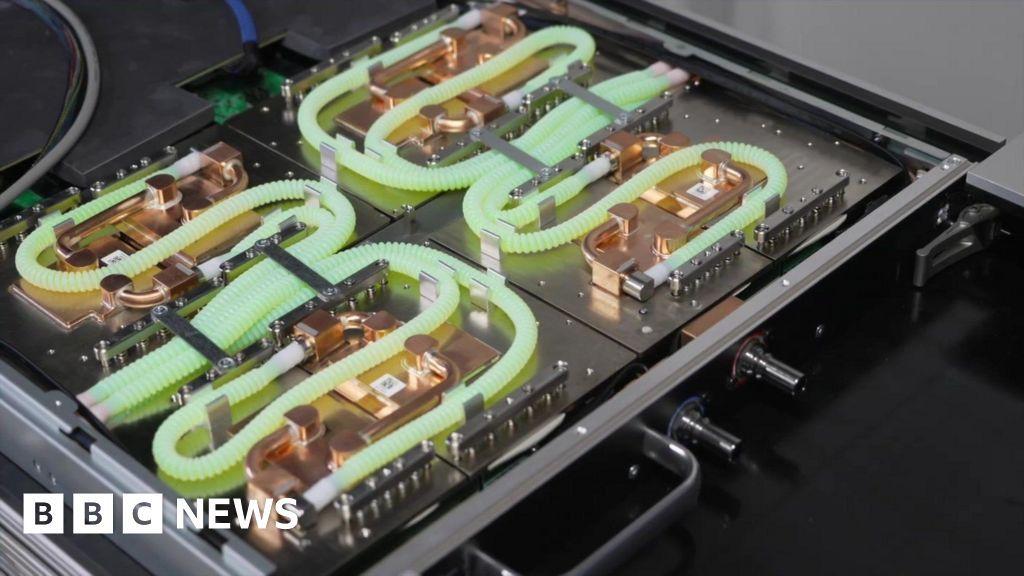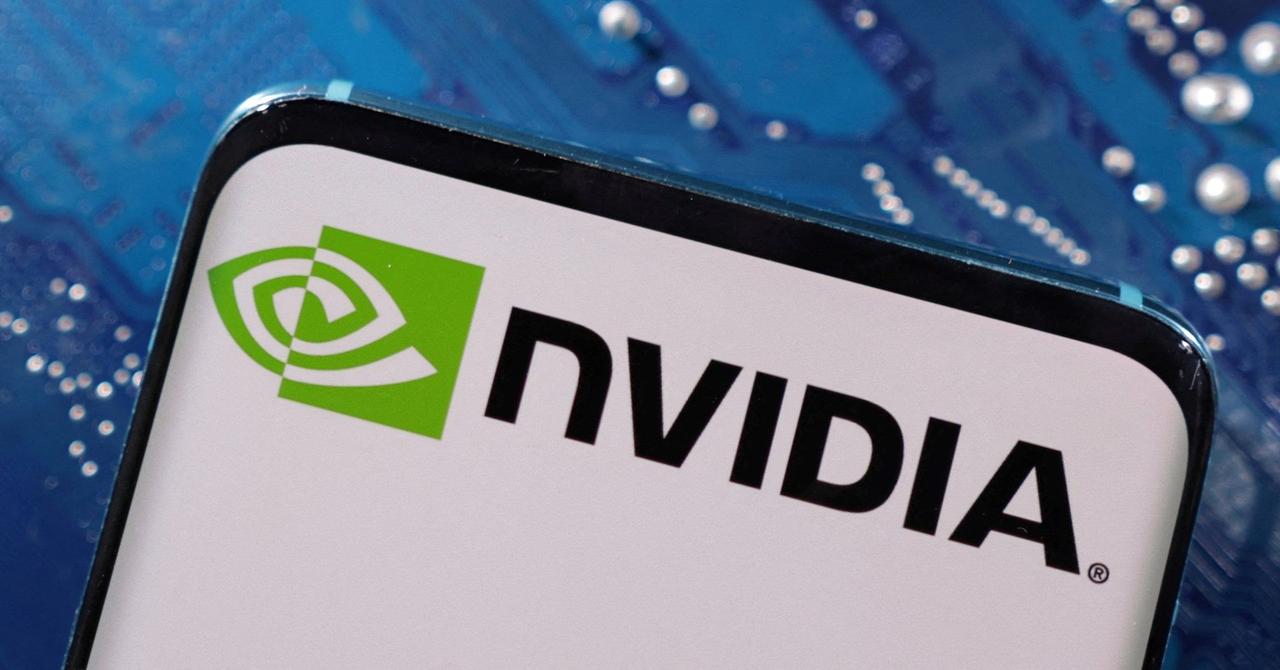JUPITER: Europe's First Exascale Supercomputer Ignites AI and Scientific Research
6 Sources
6 Sources
[1]
Meet Europe's first exascale supercomputer -- can it compete in the global AI race?
As US and Chinese technology firms have competed in the race to be innovators in artificial intelligence (AI), Europe has fallen behind. But on 5 September, a European supercomputer called JUPITER officially reached the exascale threshold, a milestone in computing power. The device could boost European research. JUPITER is the fourth-fastest computer in the world. Having surpassed one quintillion (10) operations a second, it joins an exclusive league of exascale supercomputers. According to the European Union, it is also 100% powered by renewable energy, and ranks first in energy efficiency among supercomputers. JUPITER's computational speed serves its main purpose -- to push the capabilities of research in areas such as AI, weather modelling, astrophysics and biomedical research. It gives researchers in Europe access to their own top-level supercomputer, rather than having to rely on machines in the United States and elsewhere. The milestone is "absolutely" a big deal for Europe, says Kirk Cameron, a computer scientist at Virginia Polytechnic Institute and State University (Virginia Tech) in Blacksburg, particularly with regards to AI and large language models (LLMs). "There's this race going on in the world of who will be the innovators in AI," he says. "It's taken a little bit to get [Europe] into the race. So it's really nice to see them making that progress." Nature examines what JUPITER can actually do, and what it will be used for. JUPITER, which stands for Joint Undertaking Pioneer for Innovative and Transformative Exascale Research, has been in development since 2018, with the explicit aim of giving Europe a foothold in the supercomputer race taking place around the world. Funded by the European Commission and EU member Germany, it is located at the Jülich science research centre in Germany. JUPITER booted up and performed its first computations in June, says Thomas Lippert, the project lead on JUPITER at Jülich. Running on some 24,000 NVIDIA chips, JUPITER is capable of exceeding 1,000 petaflops -- one exaflop, or one million trillion operations per second -- at its peak performance. For comparison, a typical laptop operates at one teraflop, or one trillion calculations per second. Officially, JUPITER is the fourth-fastest supercomputer in the world, with a benchmark performance of about 800 petaflops, after the United States' El Capitan (1.7 exaflops), Frontier (1.35 exaflops) and Aurora (1 exaflop). Lippert says that having a supercomputer such as JUPITER will enable Europe to develop the talent necessary to build and operate such machines in the future. "Our economy and welfare depend on these technologies," he says. The EU says that JUPITER "runs entirely on renewable energy" to limit its impact on the environment. Lippert says that this is achieved by paying to use only renewable energy from Germany's national grid. When it is running at full load, JUPITER will use 17 megawatts of power, which is equivalent to powering about 11,000 homes. Cameron says such supercomputers can be extremely power-hungry and cause problems. "You're competing with cities for power," he says. "These things start to impact the infrastructure of communities around these areas." Researchers will be able to apply to use the supercomputer up to twice a year, and 30 projects have already been selected. These include research on AI applications, such as foundation models and video generation, climate models, particle physics, energy applications and biomedical research for drug development and disease control. One of the projects is based at the European Centre for Medium-Range Weather Forecasts (ECMWF) in Bonn, Germany. "We are building weather-prediction models," says Peter Dueben, head of Earth system modelling at the ECMWF. "For this we need supercomputers." JUPITER will enable the ECMWF to increase the resolution of its models to the kilometre scale, compared with 10 kilometres at the moment. The computer could allow the model to "resolve individual clouds", says Dueben. "This is particularly important for a program called Destination Earth, where we want to build digital twins of Earth," he says, enabling the flow of air and wind around the world to be better examined. Volker Springel, an astrophysicist at the Max Planck Institute for Astrophysics in Garching, Germany, wants to use JUPITER to study the early Universe. He already has a project using the US supercomputer Frontier to model cosmic reionization, the name given to the period about one billion years after the Big Bang, when the first stars and galaxies formed. JUPITER allows scientists in Europe to run their own projects, instead of having to collaborate on programs in countries such as the United States, says Springel, and also reduces reliance on other nations in case of political or other tensions. JUPITER, which is designed to run for at least six years, will be used to train new AI models, too. JUPITER is well placed to have a role in this field, even helping to develop European LLMs, says Lippert. "JUPITER will be the basis for developing a very good language model run by two very well-known companies," he says, although he was not able to share further details. JUPITER's timing is fortuitous for building European LLMs, says Cameron, because supercomputers take a long time to plan -- JUPITER was already in the works when ChatGPT was released in November 2022. "Now it can be repurposed for AI," he says. "Europe has this huge AI initiative," making JUPITER all the more crucial in Europe's future. "People often say that Europe is behind in machine learning in comparison to the US and Asia," says Dueben. "So it was fantastic to see this big machine going live."
[2]
Europe's Jupiter supercomputer hits exascale threshold
video Europe's first exascale supercomputer has finally lived up to expectations, despite not being fully complete, as its general-purpose compute cluster is not set to be ready before next year at the earliest. The long-awaited Jupiter system was officially inaugurated on Friday at the Jülich Supercomputing Center near Köln (Cologne) in Germany, and has surpassed the exascale threshold of one quintillion (10¹⁸) operations per second, according to the European Commission. Friday's inauguration was effectively that of Jupiter's Booster module, a GPU cluster intended for handling large-scale simulations and AI training. It comprises roughly 6000 compute nodes, each featuring four of Nvidia's GH200 Grace Hopper superchips, and interconnected using the GPU-flinger's Quantum-2 InfiniBand networking gear as well. Jupiter Youtube Video It's lucky that the system managed to hit the exascale threshold for its inauguration ceremony, isn't it? (Sorry, we couldn't resist being snarky.) In attendance were German Chancellor Friedrich Merz, the Federal Minister for Research, Technology, and Space Dorothee Bär, North Rhine-Westphalia's Minister-President Hendrik Wüst, and Minister for Culture and Science Ina Brandes. The Jupiter system had already taken the crown of Europe's most powerful computer system and the worldwide fourth fastest back in June, while its Jedi test module made the top of the Green500 table of the world's most energy-efficient supercomputers a year earlier. "With Europe's first exascale supercomputer, we are opening a new chapter for science, AI and innovation," said Ekaterina Zaharieva, European Commissioner for Startups, Research and Innovation. Jupiter strengthens Europe's digital sovereignty, accelerates discovery, and ensures that the most powerful and sustainable computing resources are available to the region's researchers, innovators, and industries, she added. Europe is trailing in the wake of the US here, which achieved exascale level with the Frontier supercomputer at Oak Ridge National Laboratory three years ago, then again with Argonne National Laboratory's Aurora supercomputer last year and Lawrence Livermore National Lab's El Capitan system later the same year. China is also believed to have exascale systems, but is keeping quiet about them. The UK was planning for an exascale supercomputer of its own, to be based at Edinburgh University, but the incoming Labour government cancelled it to save cash last year, then reinstated it earlier this year, but isn't referring to it as an exascale cluster anymore. Jupiter's general-purpose Cluster Module is set to target workflows that do not benefit from accelerator-based computing - in other words, mainly CPU-based code. It will be based on the Rhea1 processor from Euro chip biz SiPearl, which only taped out the final design for it in July this year. The first sample silicon is set to be available in early 2026, meaning that the Cluster Module is expected later the same year. Rhea1 is an 80-core chip based on Arm's Neoverse V1 cores, and it is understood that the Cluster Module will feature two such processors per compute node and comprise a total of 1,300 nodes. Jupiter's systems are housed inside a high-performance modular datacenter consisting of about 50 container modules and covering more than 2,300 square meters - roughly the equivalent of half a soccer field. This arrangement is intended to allow the system to be easily reconfigured or expanded. This first exascale system for Europe is being built by the ParTec-Eviden consortium, where Eviden is the compute division of troubled Atos Group. The total cost for Jupiter and operating it over six years is estimated to amount to €500 million ($587 million), half of which is being met by the European supercomputing initiative, EuroHPC JU, while the rest will be covered by the German Federal Ministry of Education and Research (BMBF) and the Ministry of Culture and Science of the State of North Rhine-Westphalia (MKW NRW). ®
[3]
Now Live: Europe's First Exascale Supercomputer, JUPITER, Accelerates Climate Research, Neuroscience, Quantum Simulation
At JUPITER's inauguration ceremony in Jülich, attended by Germany Chancellor Friedrich Merz, the Jülich Supercomputing Centre and NVIDIA unveiled ways the supercomputer is already spurring innovation across the world. The Jülich Supercomputing Centre's JUPITER -- Europe's first exascale supercomputer -- is officially live. Unveiled today at the supercomputer's inauguration ceremony in Jülich, JUPITER is accelerating innovative applications that are out of this world. Powered by the NVIDIA Grace Hopper platform, it's enabling breakthrough research in climate, neuroscience, quantum simulation and more. Based on Eviden's BullSequana XH3000 liquid-cooled architecture, JUPITER can run 1 quintillion FP64 operations per second and is expected to offer up to 90 exaflops of AI performance, delivering more than double the speed for high-performance computing and AI workloads compared with the next-fastest system in Europe.
[4]
Europe's first exascale supercomputer is now up and running, using 24,000 Nvidia GH200 Superchips to perform more than one quintillion operations per second with nearly 1,000,000 terabytes of storage
Europe's fastest supercomputer is now operational, and boy howdy does it have an impressive specs sheet. The JUPITER project (which stands for Joint Undertaking Pioneer for Innovative and Transformative Exascale Research, apparently) had its official ribbon-cutting ceremony earlier this week at the Forschungszentrum Jülich campus in Germany, attended by the great and the good of European scientific researchers -- and the odd politician, too. JUPITER itself is built around 50 container modules over a 2,300 square meter site, and contains a simply astonishing amount of hardware. The Booster module contains roughly 6,000 nodes, over which 24,000 Nvidia GH200 Grace Hopper Superchips are interconnected via the company's Quantum-2 InfiniBand networking system, complete with a slew of Arm-based CPU cores, 288 per node. The Cluster module, interlinked with Booster, is made up of more than 1300 nodes containing a wealth of Rhea1 processors, another Arm instruction set chip and designed by SiPearl. Each cluster node has two of these chips, with each containing 80 Arm Neoverse Zeus cores. JUPITER is expected to be capable of exceeding 90 exaflops worth of AI performance and 1 quintillion FP64 operations per second running at full pelt, which is... well, rather speedy. Enough to make it the fourth fastest supercomputer in the world, in fact. You're keeping up with me, yes? Good, I'll keep going. According to an Nvidia blog, 51,000 network connections let JUPITER transmit three times more data than all global data traffic at any given moment. It's also got nearly 1 exabyte of storage, equating to around 1,000,000 terabytes, which gives it plenty of room to install at least one copy of Call of Duty: Black Ops 6. Ah, but JUPITER is destined for much greater purposes than playing silly old video games. It will instead be used for research purposes, focusing on climate science, generative AI models, neuroscience for drug discovery, mapping the human brain, and quantum simulation, among others. As a given example, the Max Planck Institute for Meteorology is said to be using JUPITER to simulate climate predictions and extreme weather events. I'm imagining the results are going to come back as something like "we're really screwed", just like every other climate science prediction I've seen over the past two decades -- but with all this computer power at its disposal, at least we've all got a good chance of knowing exactly how screwed we are in more accurate ways than ever before. Which will be nice, won't it? Anyway, it seems like some real good might come from this fantastic machine, as beyond simulating climate events, it's also going to be simulating protein assembly in cells in an effort to combat HIV, study (and potentially discover new) particle interactions, and "develop spatio-temporal compression and diffusion architectures that enable the creation of high-quality, accessible video models to advance applications from medical imaging to autonomous driving." All of which sounds like good stuff. So, put away the tired old Crysis gags, folks. This is an Nvidia-powered machine that might be doing some serious good, and one that I reckon might be worth setting aside the power requirements for. Godspeed, JUPITER. Perhaps you might be the eventual saviour of us all.
[5]
Europe's most powerful supercomputer 'Jupiter' goes live
Jupiter's power is equivalent to the capabilities of a million modern smartphones put together. The first computer system in Europe to achieve exascale threshold - or one that performs more than one quintillion operations per second - was inaugurated at the Jülich Supercomputing Centre in Germany late last week. Called Jupiter, this €500m joint investment by the European Union and Germany via the European High Performance Computing Joint Undertaking (EuroHPC) is Europe's most powerful supercomputer and the fourth fastest worldwide. Its power, to compare, aggregates the computing capabilities of one million modern smartphones. Jupiter is powered by the Nvidia's Grace Hopper platform and supported by other industry partners such as Eviden, Atos and ParTec. The system contains high-powered, energy efficient processors, including the first prototypes of processors made in the EU under the European Processor Initiative. Jupiter runs entirely on renewable energy and features state-of-the-art cooling and energy reuse, making it the world's most energy-efficient supercomputer model. The system is available to the scientific community, industries and public sectors across Europe and will run hundreds of applications around climate change, weather forecasting, material science, bio-engineering, and training large language models. It will allow researchers to run weather models at kilometre-scale resolution, enabling much more precise forecasts of extreme weather events. Jupiter will be accessible to start-ups across Europe to train and deploy generative AI models. Jupiter joins existing supercomputers in the EuroHPC network - namely, 'MareNostrum' in Spain, 'Leonardo' in Italy, 'Lumi' in Finland, 'Discoverer' in Bulgaria, 'MeluXina' in Luxembourg, 'Vega' in Slovenia, 'Karolina' in Czechia and 'Deucalion' in Portugal - together conducting billions of calculations per second. The supercomputers are a part of Europe's wider strategy to develop AI gigafactories. EuroHPC has already selected 13 proposals for its AI factories, including in Germany, Spain, Poland and France. The factories will provide access to the massive computing power that start-ups, industry and researchers need to develop their AI models, the EU said. "This is a historic milestone. With Jupiter, Europe becomes the home of the most powerful computer in Europe, and the fourth most powerful in the world," said Ekaterina Zaharieva, the commissioner for start-ups, research and innovation "Just as the planet Jupiter has a gravitational pull that shapes our solar system, the Jupiter supercomputer will pull Europe's research community, its start-ups, its industry, and its talent together. It will attract investment, stimulate breakthrough, pushing Europe forward." Nvidia CEO Jensen Huang said: "Jupiter fuses high-performance computing and AI into a single architecture. A platform for next-generation scientific computing, it will accelerate breakthroughs across every domain - from modeling climate and renewable energy to advancing quantum research, designing new materials and building digital twins." Don't miss out on the knowledge you need to succeed. Sign up for the Daily Brief, Silicon Republic's digest of need-to-know sci-tech news.
[6]
Atos: inaugurates JUPITER, "Europe's most powerful supercomputer"
Eviden, the products branch of the Atos Group, announces the inauguration of the Booster module of JUPITER, "Europe's most powerful supercomputer." The event took place at the Jülich Supercomputing Centre (JSC) in Germany. Already ranked as the most powerful high-performance computing (HPC) and artificial intelligence (AI) system in Europe and the fourth most powerful in the world, JUPITER is expected to be the first in Europe to exceed one billion billion calculations per second, a power equivalent to 10 million connected laptops. The entire system is integrated into a modular data center designed and deployed by Eviden. 'The JUPITER Booster partition integrates 24,000 NVIDIA GH200 Grace Hopper graphics processing units (GPUs), interconnected with the Nvidia Quantum-2 InfiniBand network, which is specially optimized for highly parallel applications such as AI model training or numerically demanding simulations,' Atos explains. Whether it's significantly improving extreme weather forecasting or accelerating advances in climate science, sustainable energy, AI, quantum research, and structural biology, JUPITER will empower researchers, industries, and public bodies across Europe to drive innovation on an unprecedented scale, it adds.
Share
Share
Copy Link
Europe's JUPITER supercomputer, reaching exascale performance, marks a significant milestone in the global AI and supercomputing race. This powerful machine promises to accelerate research in climate science, AI, and more.
Europe Enters the Exascale Era with JUPITER
On September 5, 2025, Europe officially joined the exascale computing club with the inauguration of JUPITER (Joint Undertaking Pioneer for Innovative and Transformative Exascale Research) at the Jülich Supercomputing Centre in Germany
1
2
. This milestone marks a significant leap forward in Europe's computing capabilities, positioning it as a formidable contender in the global artificial intelligence (AI) and supercomputing race.
Source: Nature
Technical Specifications and Performance
JUPITER's impressive specifications place it at the forefront of supercomputing technology:
- Performance: Capable of exceeding 1 quintillion (10^18) operations per second, with a benchmark performance of about 800 petaflops
1
- AI Performance: Expected to offer up to 90 exaflops of AI performance
3
- Hardware: Powered by 24,000 NVIDIA GH200 Grace Hopper Superchips across approximately 6,000 nodes
4
- Storage: Nearly 1 exabyte (1,000,000 terabytes) of storage capacity
4
- Networking: NVIDIA Quantum-2 InfiniBand interconnect, capable of transmitting three times more data than all global data traffic at any given moment
4

Source: The Register
Environmental Considerations
JUPITER sets a new standard for energy efficiency in supercomputing:
- Powered entirely by renewable energy
1
- Ranked first in energy efficiency among supercomputers
1
- Power consumption of 17 megawatts at full load
1
- State-of-the-art cooling and energy reuse systems
5
Research Applications and Impact
JUPITER's immense computing power will accelerate research across various fields:
- Climate Science: Enabling high-resolution weather models at kilometer-scale, improving extreme weather event predictions
1
5
- Artificial Intelligence: Supporting the development and training of large language models and generative AI
3
5
- Neuroscience: Advancing drug discovery and brain mapping efforts
3
- Quantum Simulation: Enhancing research in quantum computing and related fields
3
- Astrophysics: Studying the early Universe and cosmic reionization
1
- Biomedical Research: Accelerating drug development and disease control studies
1

Source: PC Gamer
Related Stories
Europe's Position in the Global Supercomputing Landscape
JUPITER's launch significantly bolsters Europe's standing in the global supercomputing arena:
- Ranked as the fourth-fastest supercomputer globally
1
2
- Strengthens Europe's digital sovereignty and research capabilities
2
- Part of a broader European strategy to develop AI gigafactories and advance technological innovation
5
Future Developments
The JUPITER project is set to expand further:
- A general-purpose Cluster Module, based on SiPearl's Rhea1 processor, is expected to be added in 2026
2
- This addition will enhance JUPITER's capabilities for workflows that do not benefit from accelerator-based computing
2
With JUPITER now operational, Europe has taken a significant step forward in the global race for AI and supercomputing supremacy. This powerful machine promises to accelerate scientific discoveries, drive technological innovation, and strengthen Europe's position in the rapidly evolving digital landscape.
References
Summarized by
Navi
[2]
[5]
Related Stories
Jupiter Supercomputer Takes Europe's HPC Crown, Poised for Exascale Performance
10 Jun 2025•Technology

Germany Unveils Jupiter: Europe's Fastest AI Supercomputer in Bid to Catch Up with US and China
06 Sept 2025•Technology

UK Launches Isambard-AI: A Powerful Supercomputer Advancing AI Research and Applications
18 Jul 2025•Technology

Recent Highlights
1
OpenAI releases GPT-5.2 AI model after code red memo signals Google Gemini 3 threat
Technology

2
Disney invests $1 billion in OpenAI, licenses 200+ characters for Sora AI video generator
Technology

3
OpenAI faces wrongful death lawsuit after ChatGPT allegedly fueled murder-suicide tragedy
Policy and Regulation





